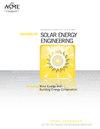Effect of Nanoparticles Deposition on Cooling Performance of Photovoltaic Panels
IF 1.9
4区 工程技术
Q3 ENERGY & FUELS
Journal of Solar Energy Engineering-transactions of The Asme
Pub Date : 2023-10-03
DOI:10.1115/1.4063620
引用次数: 0
Abstract
Abstract The current research aims to investigate the deposition and dispersion of nanoparticles for thermally developing laminar flow inside a cooling channel of a photovoltaic (PV) panel. The particle transport is modeled in an Eulerian-Lagrangian framework using a two-way coupling approach to perform the particle trajectories. In the absence of turbulent fluctuations, Brownian diffusion is the main force that contributes to particles deposition due to the small size of the particles used in the current study (below 100 nm). Several parameters were investigated such as inlet temperature, Reynolds number, nanoparticle size, and concentration in order to record the subsequent effects on the deposition efficiency, heat transfer coefficient, and pressure drop. There is no direct particle deposition model available in commercial computational packages such as Fluent, so a deposition model was developed and programmed in C-language using the User-Defined Functions (UDF) capabilities available in the Fluent solver to model how the particles are affected by wall impacts. Model validation was performed against the experimental studies found in the literature and showed good agreement. The efficiency of particle deposition on the channel wall was found to increase with decreasing nanoparticle size and/or Reynolds number. Furthermore, the deposition efficiency increased with the increase in fluid inlet temperature and nanofluid concentration. Moreover, the heat transfer rate was decreased as a result of decreasing nanofluid concentration caused by nanoparticle deposition on the channel walls, while the pumping power was also decreased due to concentration loss.纳米颗粒沉积对光伏板冷却性能的影响
摘要:本研究旨在研究纳米颗粒在光伏板冷却通道内热层流的沉积和分散。粒子输运在欧拉-拉格朗日框架中建模,使用双向耦合方法来执行粒子轨迹。在没有湍流波动的情况下,由于当前研究中使用的颗粒尺寸较小(小于100 nm),布朗扩散是导致颗粒沉积的主要力量。研究了入口温度、雷诺数、纳米颗粒尺寸和浓度等参数对沉积效率、传热系数和压降的影响。在商业计算软件包(如Fluent)中没有直接的颗粒沉积模型,因此使用Fluent求解器中可用的用户定义函数(UDF)功能,用c语言开发并编程了沉积模型,以模拟颗粒如何受到壁面撞击的影响。模型验证与文献中发现的实验研究结果一致。颗粒沉积在通道壁上的效率随着纳米颗粒尺寸和/或雷诺数的减小而增加。此外,沉积效率随流体入口温度和纳米流体浓度的增加而增加。此外,由于纳米颗粒沉积在通道壁上导致纳米流体浓度降低,传热速率降低,而浓度损失也导致泵送功率降低。
本文章由计算机程序翻译,如有差异,请以英文原文为准。
求助全文
约1分钟内获得全文
求助全文
来源期刊
CiteScore
5.00
自引率
26.10%
发文量
98
审稿时长
6.0 months
期刊介绍:
The Journal of Solar Energy Engineering - Including Wind Energy and Building Energy Conservation - publishes research papers that contain original work of permanent interest in all areas of solar energy and energy conservation, as well as discussions of policy and regulatory issues that affect renewable energy technologies and their implementation. Papers that do not include original work, but nonetheless present quality analysis or incremental improvements to past work may be published as Technical Briefs. Review papers are accepted but should be discussed with the Editor prior to submission. The Journal also publishes a section called Solar Scenery that features photographs or graphical displays of significant new installations or research facilities.

 求助内容:
求助内容: 应助结果提醒方式:
应助结果提醒方式:


